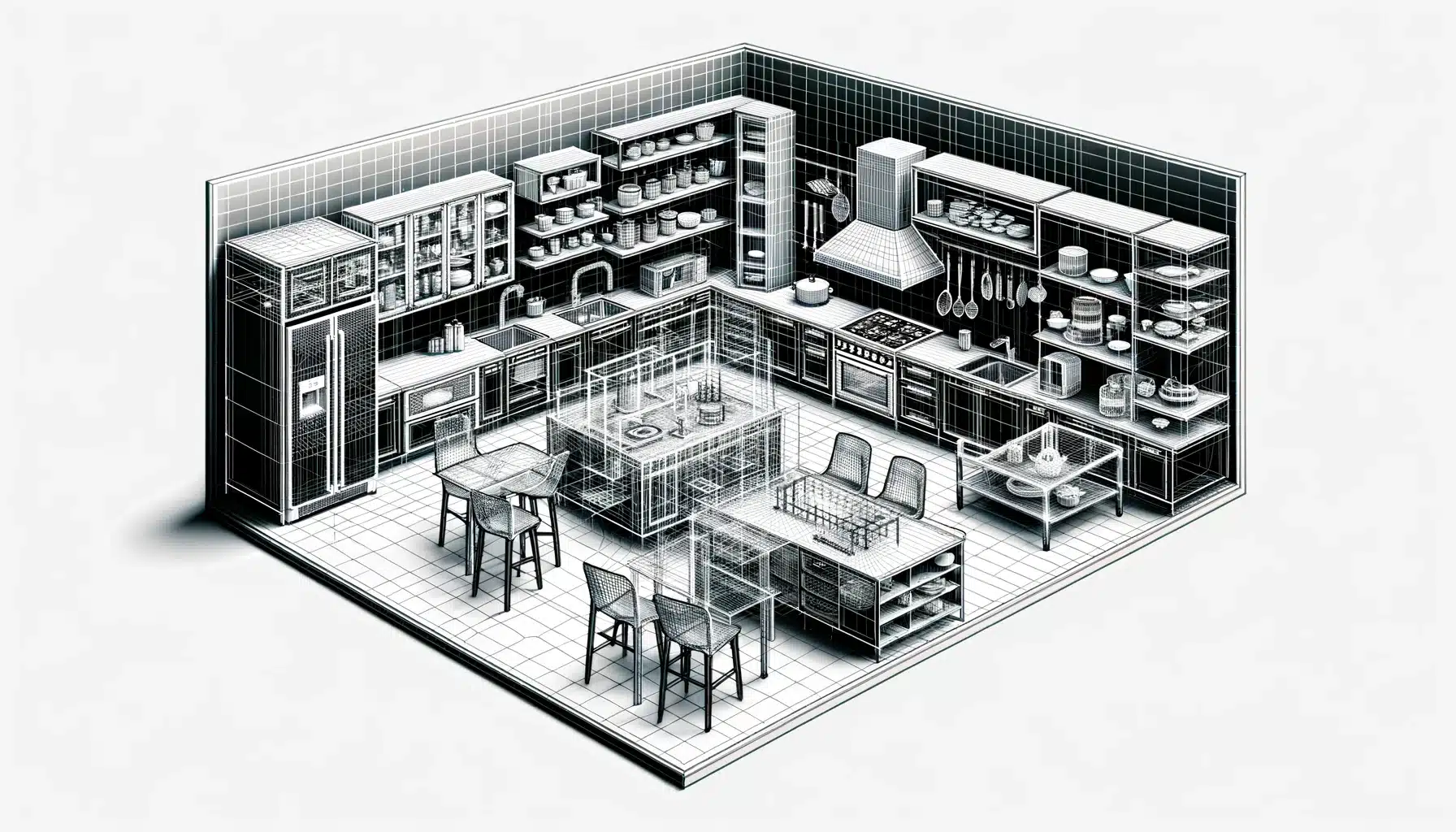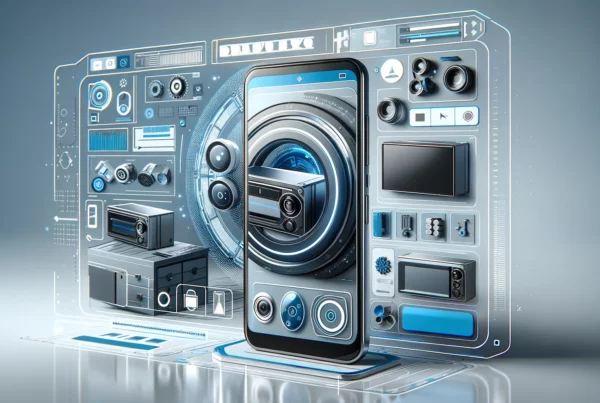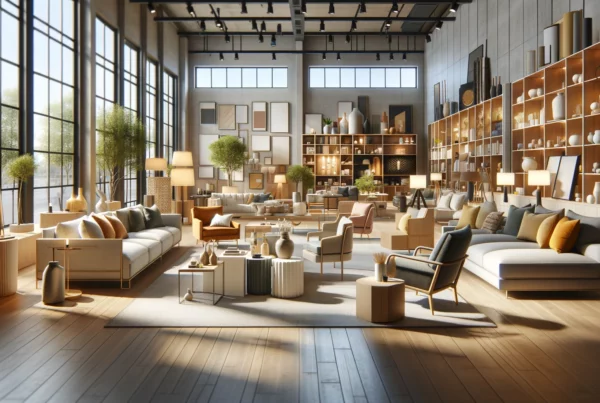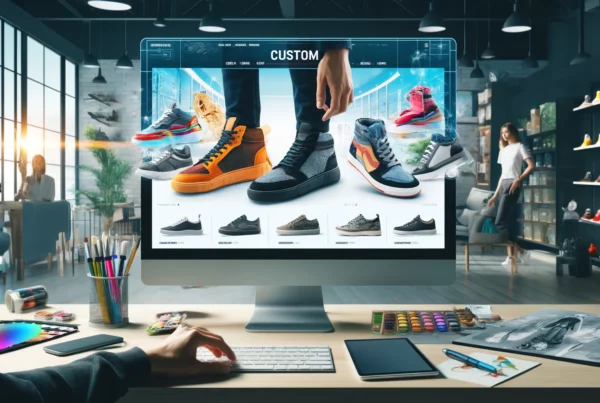Visual Commerce for Kitchens masterfully combines state-of-the-art technology with traditional craftsmanship, redefining the presentation of kitchen products in the digital arena. As the landscape of retail shifts predominantly to online platforms, providing immersive, captivating visual experiences has become indispensable.
Augmented Reality (AR) represents a transformative technology, altering the way consumers interact with and conceptualize kitchen designs and configurations. Seamlessly incorporating AR into the shopping experience enables customers to project their ideal kitchen into their actual living spaces, fostering a deeper emotional connection and enhancing their confidence in their purchasing decisions.
As leaders in the field of AR technology, we are intimately aware of the significant impact that rich, immersive visuals have on consumer behavior.
Our commitment to excellence ensures that each customer interaction with our visual commerce offerings elevates beyond mere transactions, enhancing sophistication and pushing the boundaries of kitchen design artistry.
In this article, we will uncover the diverse aspects of visual commerce for kitchens, investigating how 3D configurators, bespoke augmented reality experiences, superior product photography, advanced configuration tools, and streamlined order processing are revolutionizing the kitchen industry.
Enhancing Kitchen Visuals for E-Commerce
In the dynamic domain of e-commerce, enhancing kitchen visuals represents a critical stride towards capturing consumer interest and driving engagement. With the strategic application of Augmented Reality (AR), we can transform static images into interactive, three-dimensional experiences that allow users to truly visualize their potential kitchen spaces in real-time and in their own homes. This innovative approach not only elevates the aesthetic presentation but also provides a tangible sense of scale and perspective, which are crucial for customers making significant decisions from afar. As a result, our enhanced visuals not only beautify but also build trust and confidence, paving the way for informed and satisfied purchases.
In the realm of e-commerce, particularly within the kitchen industry, the application of Augmented Reality (AR) serves as a cornerstone for innovation. We are committed to transcending traditional online shopping by offering an interactive visual experience that brings kitchen designs to life with stunning realism. Our approach involves integrating dynamic, high-fidelity AR visuals that allow customers to engage with each element of their prospective kitchen in their own space, giving them a powerful tool for visualization and decision-making. This technology not only enhances the aesthetic appeal of products but also instills a deeper confidence in the purchase decision, ultimately fostering a richer, more satisfying shopping experience.
Captivating Customers with 3D Configurators
Captivating customers with 3D configurators involves more than just displaying options; it’s about creating an engaging and interactive environment where they can see their ideas come to life. These powerful tools allow individuals to experiment with different kitchen designs by adjusting colors, materials, and layouts with just a few clicks.
This interactive process not only enhances the customer’s ability to visualize potential outcomes but also boosts their confidence in decision-making. As they tweak and transform their virtual kitchen, they gain a clearer understanding of what works best for their space, ensuring that the final product is exactly what they envisioned.
This deep engagement results in a more satisfying shopping experience and a stronger connection to the purchased product.
Personalized Augmented Reality Experiences
Personalized Augmented Reality (AR) experiences are redefining the customer journey in kitchen design, offering a tailor-made interface where every selection reflects the individual’s unique taste and requirements.
By overlaying virtual objects onto real-world environments, AR allows customers to visualize how new kitchen elements will look in their own homes.
This immersive technology facilitates a deeper connection between the product and the consumer, enhancing their confidence as they make choices that align perfectly with their personal aesthetics and functional needs.
Further enhancing the user experience, AR incorporates real-time modifications and feedback, allowing customers to see the effects of their choices instantly. This dynamic interaction not only makes the design process more enjoyable but also significantly more efficient, reducing the likelihood of post-purchase dissatisfaction.
As customers adjust elements like the color of cabinets or the placement of islands, they experience a sense of empowerment and satisfaction, knowing their final decisions are well-informed and truly their own.
The Power of Product Photography
The power of product photography in the realm of kitchen commerce cannot be overstated. High-quality images serve as the first point of engagement, captivating potential buyers by showcasing the intricate details and craftsmanship of kitchen products. These photographs help to bridge the gap between online browsing and physical reality, offering a clear and attractive representation of items that customers cannot touch or see in person. Effective product photography conveys not only the quality and design of the products but also sets the mood and style, appealing directly to the aesthetic preferences of consumers.
Furthermore, advanced product photography techniques, such as 360-degree views and zoom-in capabilities, enable customers to explore every aspect of a product as if they were examining it in person. This level of detail empowers consumers to make informed decisions by providing a thorough understanding of the product’s features and benefits. By allowing customers to visualize how these items would look and function in their own spaces, product photography plays a crucial role in reducing hesitation and boosting conversion rates, ultimately driving sales and enhancing customer satisfaction.
Advanced Configuration Capabilities
Advanced configuration capabilities in kitchen design tools are transforming the way customers plan and purchase their ideal kitchens. These sophisticated systems enable users to select from a wide array of options, such as different materials, finishes, and appliance models, to customize their kitchen down to the smallest detail.
With intuitive user interfaces, these configurators make it possible for even those without technical expertise to design a kitchen that meets their specific needs and preferences. This level of customization not only enhances the user experience but also ensures that the finished kitchen will truly reflect the individual’s lifestyle and aesthetic desires.
Additionally, the integration of real-time pricing updates and compatibility checks within these configurators adds a layer of practicality to the customization process. As customers adjust and refine their selections, the system automatically updates the cost and ensures that all components work harmoniously together.
This helps to prevent any potential issues that could arise from incompatible choices and provides a transparent pricing structure throughout the design process. By empowering customers with these advanced configuration tools, businesses can foster greater trust and satisfaction, ultimately leading to higher sales and loyalty.
Automating Order Processing
Automating order processing in the kitchen design industry is a critical step towards enhancing efficiency and customer satisfaction. By implementing automated systems, businesses can streamline the entire purchasing process, from initial design approval to final order fulfillment.
This not only speeds up transaction times but also reduces the likelihood of human errors that can occur during manual entry. Customers benefit from a smoother, faster service where their custom kitchen orders are processed with precision and dispatched for production without delay.
Moreover, automation in order processing allows for better tracking and management of orders. Companies can provide real-time updates to customers about the status of their orders, including expected delivery times. This transparency builds trust and reassures customers that their investments are being handled professionally. Additionally, automation frees up valuable staff time, enabling employees to focus more on customer service and less on administrative tasks.
This shift not only improves operational efficiency but also enhances the overall customer experience by ensuring that each interaction with the company is positive and focused on customer needs.
The Advantages of Visual Commerce for Kitchens
Visual commerce for kitchens brings many benefits by using digital tools to enhance the shopping experience. This method allows customers to see realistic images and models of kitchen designs before they buy anything. It’s like bringing the showroom experience to them online. Customers can try out different styles, arrangements, and finishes in a virtual setting, which helps them make better choices based on their own needs and the space they have. This makes shopping less risky, especially when buying big-ticket items online, and generally makes customers happier with their purchases.
Moreover, visual commerce makes shopping more interactive. With tools like 3D configurators and augmented reality, customers can change and personalize kitchen designs in real-time. They can play around with different looks and see the results right away. This not only makes shopping more fun but also keeps customers engaged longer, which can lead to more sales. Overall, visual commerce for kitchens helps businesses stand out by providing a unique and engaging way to shop, attracting and keeping more customers.
Conclusion
In conclusion, visual commerce for kitchens significantly improves the shopping experience by combining the convenience of online shopping with the benefits of seeing products up close, as you would in a showroom. It allows customers to explore and customize kitchen designs from the comfort of their home, helping them make confident decisions about their purchases. This approach not only makes shopping more engaging and fun but also helps businesses attract more customers and boost sales. By embracing these advanced digital tools, kitchen retailers can provide a better, more interactive service that meets the modern shopper’s needs.





